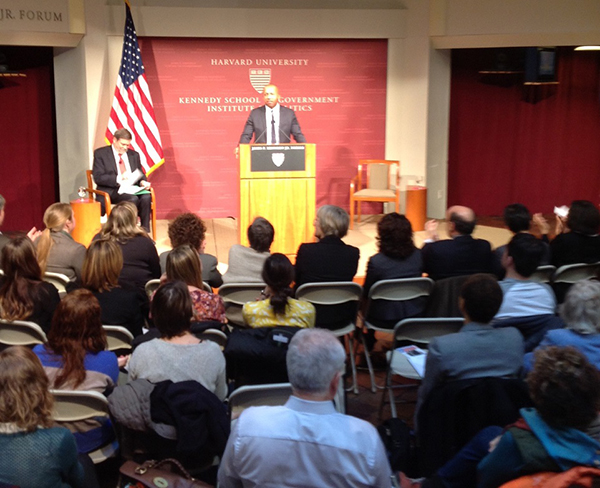Four Takeaways from Bryan Stevenson’s Talk at Harvard

Bryan Stevenson speaking at the JFK School of Government. / Photo by Jean Trounstine
Just Mercy author Bryan Stevenson, who has been called “America’s Mandela” for fighting against racial bias and wrongful convictions on death row, mesmerized his audience at Harvard last Thursday. While the topic advertised was “Justice in an Era of Mass Imprisonment,” Stevenson, who attended both Harvard Law School and the JFK School of Government, set his sights on inspiring students to create change.
With tears in his eyes, he told rapt listeners that he would always remember this particular day and this talk, because, just hours earlier, the founder and director of the Equal Justice Initiative (EJI) of Alabama, received news that client Anthony Ray Hinton was freed from prison after 30 years. Stevenson received a standing ovation.
Hinton was the latest of 116 men, women, and children whom EJI has fought to free or offer relief to from unduly harsh sentences. As Stevenson told his audience staggering statistics—like how one in three black male babies were expected to grow up and go to prison in his lifetime, the incarceration rate of women had soared almost 650 percent between 1980 and 2010, and our 2.2 million incarcerated made the country a radically different place than it was 40 years ago—he set the stage for discussing four elements of creating greater justice:
1. Get Closer
While many are taught to stay away from places where there is inequality and suffering, Stevenson said, “Get close to people you care about helping. Proximity is essential because it will change you.” An example: lawyers came into his rural community in Delaware when he was a child and forced the community to integrate schools in response to Brown v. Board of Education. He said, “You always have to get close—it grounds us.”
2. Change the Narrative
“We must change the narrative” from the one we have currently about mass incarceration, which Stevenson said is driven by the “politics of fear and anger.” For example, he noted that this mistaken belief runs political campaigns: “We need to be tough on crime.” Stevenson asked, “Why is the United States the only country that has not signed the Convention on the Rights of the Child?” Because, Stevenson answered, some states have still not stopped being “tough on crime” and insist on “demonizing kids to die in prison—mostly black and brown boys.” And this—despite changes in law, in spite of the fact that there is scientific data of the vulnerability in all children.
3. Protect Our Hope
Stevenson believes we can reduce prison populations by 50 percent in 10 years. “We have to protect our hope.” He elaborated on this with stories from Just Mercy, telling of a prison guard who insisted Stevenson be strip searched in spite of his attorney status. This correctional officer had a truck with a KKK insignia and a sign which read “If I’d known it was gonna be like this I would have picked my own damn cotton.” Stevenson managed to create a turnaround with this man, but it took persistence. He believes “Sometimes you got to stand when everybody else is sitting.”
4. Do Things That Make You Uncomfortable
Stevenson said that he believes the opposite of poverty is not wealth, it is justice. His fourth idea to create a just world is: “We have to choose to do uncomfortable things.” It is “another metric in your commitment to justice,” he told students.
You can watch Stevenson’s full talk at harvard.edu. Also check out his 2012 TED talk, which has been viewed more than 2 million times.

